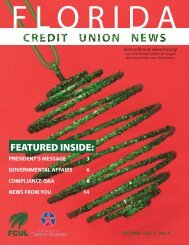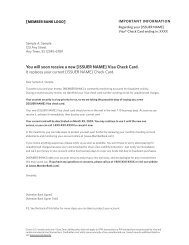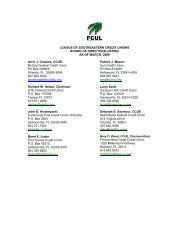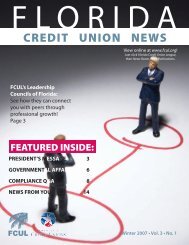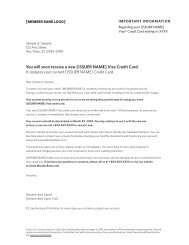credit union news - Home - Welcome to Florida Credit Union League
credit union news - Home - Welcome to Florida Credit Union League
credit union news - Home - Welcome to Florida Credit Union League
Create successful ePaper yourself
Turn your PDF publications into a flip-book with our unique Google optimized e-Paper software.
COMPLIANCE Q&ACompliance CornerBy Bill Berg, CCUE, CUCE, FCUL VP of ComplianceBill BergIf you havequestions onadditional <strong>to</strong>pics,visit InfoSight atwww.fcul.org, call800.342.1266,or 850.576.8171ext. 1028, fax <strong>to</strong>850.558.1029, oremail billb@fcul.org.Q: With the new interagency “red flag”regulations and guidelines, do we need <strong>to</strong> startfrom scratch or can we incorporate our currentfraud prevention procedures in<strong>to</strong> ID theftprevention programs?A: When appropriate, <strong>credit</strong> <strong>union</strong>s may incorporateexisting fraud prevention policies and procedures in<strong>to</strong>its ID Theft Prevention Program.The National <strong>Credit</strong> <strong>Union</strong> Administration(NCUA), Federal Trade Commission (FTC) and thefederal banking agencies issued final guidelines andregulations <strong>to</strong> implement Section 114 of the Fair andAccurate <strong>Credit</strong> Transaction Act (FACTA).Section 114 defines the identity theft “red flags,”and in this case:• NCUA’s regulations will apply <strong>to</strong> federal <strong>credit</strong><strong>union</strong>s;• FTC’s regulations will apply <strong>to</strong> state-chartered<strong>credit</strong> <strong>union</strong>s.The rules are substantially similar and have amanda<strong>to</strong>ry compliance date of November 1, 2008.The interagency “red flag” regulations requireinstitutions <strong>to</strong> develop and implement a written“Identity Theft Prevention Program,” which isdesigned <strong>to</strong> “detect, prevent, and mitigate identitytheft in connection with the opening of a coveredaccount or any existing covered account.”The regulation defines covered accounts as:• Offered or maintained primarily for personal,family, or household purposes that involveor are designed <strong>to</strong> permit multiple paymentsor transactions such as a <strong>credit</strong> card account,mortgage, loan, au<strong>to</strong>mobile loan, checkingaccount or share account; and• Any other account the <strong>credit</strong> <strong>union</strong> offersor maintains for which there is a reasonablyforeseeable risk <strong>to</strong> members or <strong>to</strong> the safety andsoundness of the federal <strong>credit</strong> <strong>union</strong> from IDtheft, including financial, operational, compliance,reputation, or litigation risks.The regulations’ accompanying guidelines makeclear that a <strong>credit</strong> <strong>union</strong> may incorporate existingfraud prevention policies and procedures in<strong>to</strong> the IDTheft Prevention Program, as appropriate.According <strong>to</strong> the supplemental information,this will avoid duplication and allow <strong>credit</strong> <strong>union</strong>s<strong>to</strong> benefit from existing policies and procedures.However, the <strong>credit</strong> <strong>union</strong> may only incorporateexisting policies, procedures, and arrangements thatcontrol reasonable foreseeable risks <strong>to</strong> members or<strong>to</strong> the safety and soundness of the <strong>credit</strong> <strong>union</strong> fromidentity theft.Q: Do our members incur tax liability if weforgive a portion of the mortgage debt?A: In certain circumstances, the answer will be no.The Mortgage Forgiveness Debt Relief Act of 2007became Public Law (PL) number 110-142 when theact, was signed in<strong>to</strong> law December 20, 2007. Thislaw is intended <strong>to</strong> provide temporary tax relief <strong>to</strong>homeowners who might lose their home <strong>to</strong> foreclosureor who negotiate a loan modification.Previously under our tax code, if a lender(voluntarily or involuntarily) forgave a portion of aborrower’s mortgage debt, the forgiven amount had<strong>to</strong> be treated as taxable income. <strong>Credit</strong> <strong>union</strong>s andother lenders had <strong>to</strong> file Form 1099-C, “Cancellationof Debt,” <strong>to</strong> report <strong>to</strong> the IRS any debt of $600 ormore, cancelled or forgiven.The new law allows the discharge of indebtednesson loans up <strong>to</strong> $2 million and secured by the borrower’sprincipal residence not <strong>to</strong> trigger federal incometaxation. PL 110-142 covers only discharges madebetween January 1, 2007 and December 31, 2009.1099-C filing requirements have not disappearedfor other types of debts that are not fully repaid.We expect, in the future, <strong>to</strong> receive guidancefrom the IRS on how <strong>to</strong> handle information returnsduring this temporary period.For upcoming compliance education andtraining as well as other <strong>League</strong> complianceresources, see page 19.Spring 2008 7



